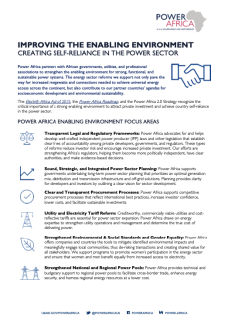Enabling Environment
Enabling Environment Principles
Power Africa partners with governments to strengthen enabling environments and implement critical reforms. While every economic and political environment will require a unique, tailored approach, Power Africa is guided by two core sets of principles that highlight key elements for achieving our goals of increasing private sector investment and doubling electricity access in sub-Saharan Africa. The first comprises principles for creating and maintaining a functional power system that meets demand, remains financially solvent, attracts private and public investment, and provides quality service to end-users. The second includes principles to ensure that the power sector contributes optimally to a country’s national and regional agenda for environmental, economic, and social development.
Principles for a Strong, Functional and Sustainable Power System
Creating Strong, Transparent Legal and Regulatory Frameworks
Creating and maintaining an effective enabling environment requires a strong and transparent regulatory framework that facilitates both private and public investment. This framework should include a regulatory institution that [1] is autonomous, [2] has clear authority and capacity to fulfill its mandate, and [3] is held accountable for its decisions and actions. It should also establish and maintain clear relationships and lines of accountability between key power sector institutions, including Ministries, utilities, and the regulator. The framework should also clarify important regulatory aspects such as pricing, land rights, offtake arrangements, and performance standards - which can reduce investor risk while contributing to other public policy objectives such as environmental protection and universal access.
Creditworthy Off-takers
Lack of investor confidence in the creditworthiness of off-takers hinders electricity sector development. Efficient, financially solvent off-takers mitigate investor risk and encourage increased private sector participation.
Cost-Reflective Retail Tariff Structures
Investments in the power sector will only be sustainable if the tariff structure accurately reflects costs and risks, and provides a rate of return that encourages continued private sector engagement. This must be carefully balanced against the critical need to protect consumers, ensure affordability, and expand electricity access. Cost-reflective tariffs often take time to achieve, and there are many different ways to structure the retail tariff system depending on the best fit for a particular country or context. In general, effective tariff management strategies include public engagement, transparent processes, regular adjustment, and appropriate measures to ensure affordability.
Technical and Commercial Efficiency
Improved technical and commercial efficiency in the electricity sector will enable delivery of more services to more consumers; lower costs throughout the supply chain; and increased quality and commercial viability. Efficiency can be improved through interventions including infrastructure investment and maintenance, improved metering and bill collection, demand-side management, and consumer education.
Clear and Transparent Procurement Processes
Procurement processes that integrate international best practices such as fair and competitive bidding, life-cycle cost analysis, and best-value determination will increase investor confidence, lower costs, and facilitate sustainable, longer-term investments.
Sound, Strategic and Integrated Power Sector Planning
Effective planning helps ensure the development of a resilient and least-cost power system that continues to meet demand over time. Power sector planning should consider and integrate key development goals as well as interactions with water, land-use, and air quality. Effective planning will prioritize an optimal mix of energy resources to meet the expected load, new or extended transmission and distribution infrastructure, energy efficiency measures, and off-grid solutions.
Streamlined and Transparent Processes for Project Development
Overly complex procedures for mobilizing energy projects often hinder sector development. Streamlining and clearly communicating the steps required to achieve essential project components such as land acquisition, feasibility studies, standards compliance, helps private sector actors navigate and accelerate this process while bringing down transaction costs.

Principles for Power Systems that Fuel Economic and Social Development
Increased Clean Energy Share
Employing clean energy technologies is crucial for diversifying energy markets, increasing energy security and resilience, expanding off-grid access, and mitigating environmental impacts. Portfolios of targeted regulatory and support mechanisms contribute to a framework that incentivizes renewables at multiple scales.
Strong Regional Power Pools
Functional regional power pools facilitate cross-border electricity trade, create economies of scale, and present opportunities to harness regional energy resources at lower cost. The success of regional power pools is governments and operators. Fundamental consensus-building documents including intergovernmental and inter-utility MOUs should clearly define utilities’ contractual rights, ownership of assets, and basic principles covering the technical planning, operations, and commercial aspects of regional power system integration.
Universal Electricity Access, Achieved through the Strategic Use of On-grid, Off-grid, and Small-scale Solutions
Investments in new power supply should respond to the demand of key market sectors, including commercial and urban consumers, while expanding access to low income and rural off-grid communities. This includes meeting the power needs of key public sector facilities such as schools, health centers, and other community buildings. Interventions to support universal access should consider a strategic mix of on-grid, off-grid, and small-scale power solutions such as mini- and micro-grids. Activities could also include strengthening or creating rural electrification agencies; establishing targeted cross-subsidies; implementing net metering programs; and promoting the development of a functional market for mini-grids and other distributed generation solutions.
Adherence to Internationally Recognized Environmental and Social Standards and Best Practices
The environmental and social soundness of power sector projects are critical to the success and sustainability of these investments. Engagement with local communities, including traditionally marginalized groups, to identify and mitigate risks begin at the earliest stages of project development and continue throughout implementation in a transparent and inclusive manner. Demonstrated commitment to environmental and social sustainability is evidenced by the adoption and application of national laws, regulations, and best practices.
Gender Equality and Female Empowerment
Advancing gender equality and female empowerment is a key tenet underlying US foreign policy and development assistance. The human development and economic growth opportunities that arise from growth in the energy sector often do not offer equal participation and impact between men and women. Energy related projects, programs and policies that explicitly recognize imbalances and intentionally strive to reduce inequities and foster effective engagement of all result in better outcomes, both in terms of the sustainability of the energy sector and human development opportunities.
DOWNLOAD Enabling Environment Fact Sheet


